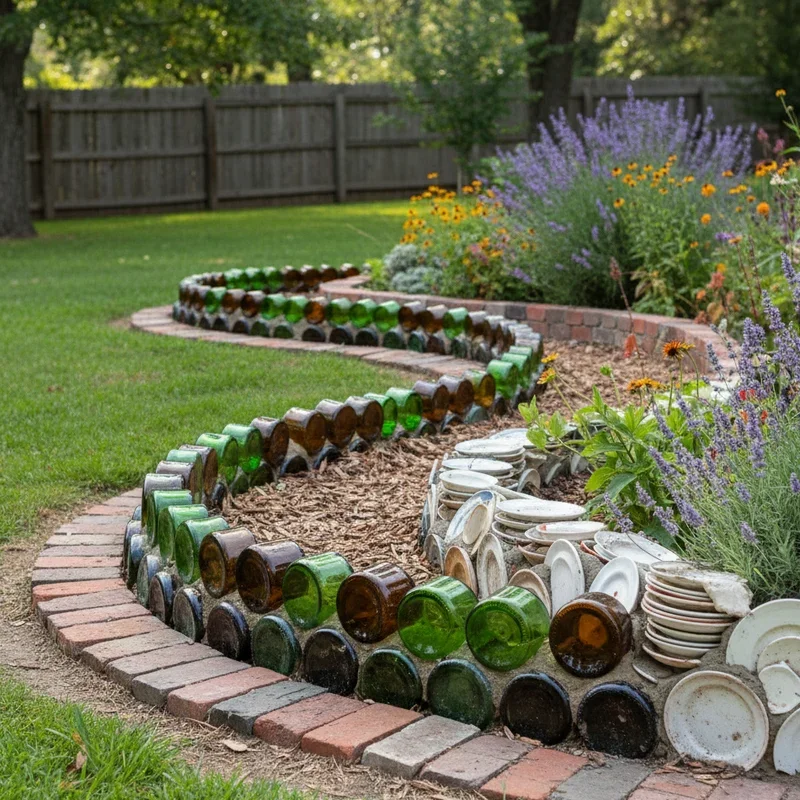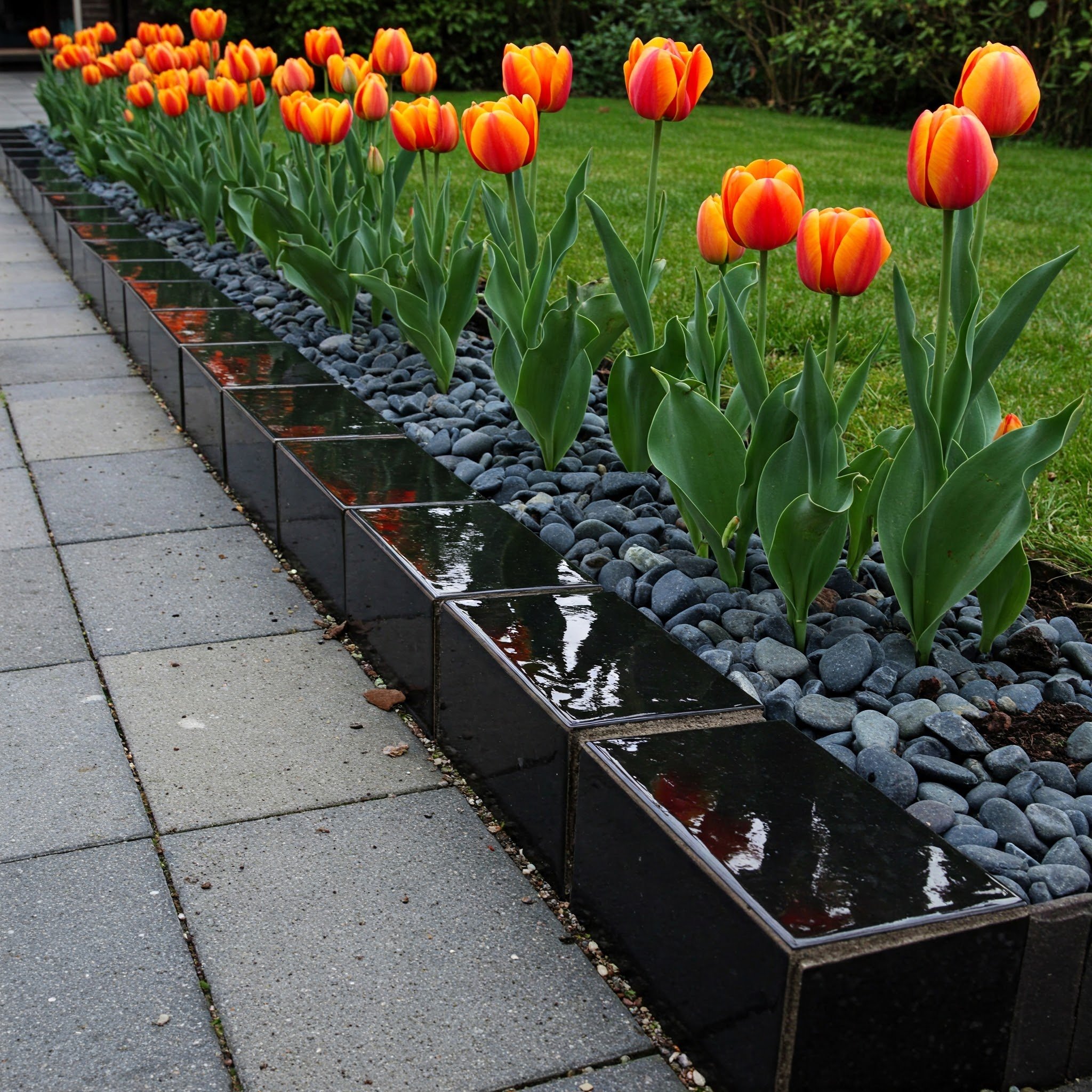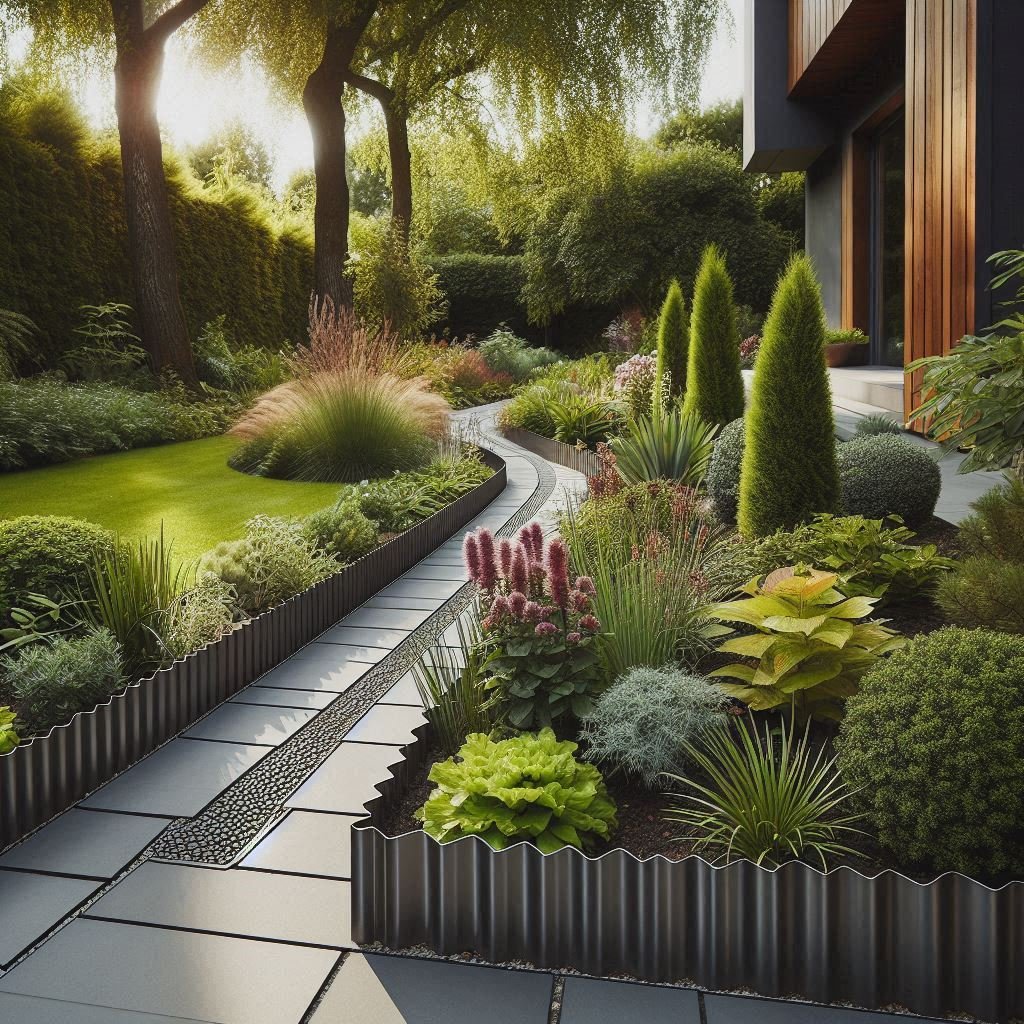15 Recycled Garden Edging Ideas for a Greener Garden
Transform waste into wonderful garden borders with 15 creative recycled edging ideas using bottles, tires, and more for eco-friendly landscaping.
What if your garden could be both beautiful and a champion for the environment? That's the promise of recycled garden edging, where yesterday's trash becomes today's landscape treasure! In an era where sustainability matters more than ever, transforming discarded materials into functional garden borders isn't just creative; it's a small act of environmental heroism. Whether you're working with wine bottles from last year's celebrations or old tires destined for the landfill, these materials can define your garden beds while keeping waste out of our ecosystems. The beauty of recycled edging lies in its dual purpose: creating distinct boundaries for your plants while giving materials a second life they desperately deserve. From colorful glass bottles catching sunlight to weathered bricks telling stories of demolished buildings, each recycled border adds unique character no store-bought edging can match. Ready to discover how your commitment to green living can translate into gorgeous garden design that makes both your plants and the planet happy?
1. Glass Bottle Garden Borders
Transform empty wine and beer bottles into stunning garden edging that catches light while defining your planting areas beautifully! Bury bottles neck-down along bed perimeters, creating colorful borders that sparkle in sunlight and add vertical interest to flat landscapes. Group bottles by color for monochromatic elegance or mix hues for rainbow effects that make gardens feel celebratory year-round. The glass acts as a mini greenhouse, warming soil edges slightly and potentially extending growing seasons for border plants. Green bottles complement foliage naturally while blue glass adds unexpected color that makes flowers pop. This method works especially well for herb gardens where the bottle tops create interesting textural contrast with soft plant materials. Clean bottles thoroughly and remove labels for best appearance, though some gardeners prefer keeping labels for added personality and conversation starters.
2. Old Tire Edging Solutions
Give worn-out tires new purpose as durable garden edging that withstands weather while keeping grass from invading flower beds! Cut tires in half to create curved sections perfect for following garden contours, or use whole tires as raised bed frames for vegetables. Paint tires in bright colors to add whimsy or leave them black for subtle definition that doesn't compete with plants. The rubber material provides excellent insulation, protecting roots from temperature extremes while lasting decades without decomposition. Stack smaller tires for terraced effects on slopes or partially bury them for low-profile borders that still provide effective barriers. Some gardeners turn tires inside out for different textures or cut decorative patterns into sidewalls for added visual interest. This virtually indestructible edging solution keeps millions of tires from landfills annually while providing practical garden structure.
3. Reclaimed Brick Pathways
Salvage old bricks from demolition sites or renovation projects to create classic garden edging with historical character! These weathered bricks bring instant patina that new materials can't replicate, adding established charm to even young gardens. Lay bricks flat for subtle borders or stand them on edge for more prominent definition between lawn and planting areas. The varied colors in reclaimed bricks, from deep reds to soft oranges, create natural patterns that complement both formal and cottage garden styles. Mortar isn't necessary for most edging applications; simply nestle bricks tightly together and let soil settle around them. Mix brick sizes and styles for eclectic appeal or maintain uniformity for cleaner lines. The thermal mass of brick moderates soil temperature while the porous material allows beneficial water movement between garden zones.
4. Plastic Bottle Barriers
Convert plastic bottles into functional garden edging that keeps waste from oceans while organizing your outdoor spaces! Fill clear bottles with colored water, sand, or pebbles for added visual interest, creating customizable borders that can change with seasons or moods. Bury bottles halfway for stable edging that won't shift during lawn maintenance or heavy rains. The plastic provides effective root barriers preventing aggressive plants from spreading where they shouldn't. Create patterns by alternating bottle sizes or colors, turning necessary borders into decorative elements that spark conversations about sustainability. This lightweight solution works perfectly for renters who need portable edging they can take when moving. Some gardeners use bottles as mini greenhouses for border seedlings, removing tops and placing over young plants for protection.
5. Salvaged Wood Borders
Repurpose old fence boards, deck planks, or fallen branches into rustic garden edging that brings natural warmth to landscape designs! Weather-worn wood adds instant character while providing sturdy borders that define spaces effectively. Cut boards to consistent heights for formal looks or vary lengths for more organic, naturalistic borders that feel like they've always been there. The decomposition process of wood enriches surrounding soil, making this option both decorative and beneficial for plant health. Treat wood with natural preservatives like linseed oil to extend life while maintaining eco-friendly principles. Stack thin boards horizontally for layered effects or position thick beams vertically for substantial borders that double as garden seating. This versatile material works in any garden style from modern minimalist to cottage garden chaos.
6. Broken Concrete Edging
Transform demolition waste into "urbanite" edging that mimics expensive flagstone while diverting heavy materials from landfills! Break large concrete pieces into manageable sizes using a sledgehammer, creating irregular shapes that fit together like puzzle pieces. The varied thicknesses and textures of broken concrete add dimensional interest that flat edging materials lack. Stack pieces for low retaining walls or lay flat for pathway edges that develop moss and lichen over time. Paint concrete pieces for pops of color or leave natural for industrial charm that complements modern garden designs. This heavy-duty edging stays put without anchoring, making it perfect for permanent landscape features. The gaps between pieces provide drainage and habitat for beneficial insects while preventing solid barrier problems.
7. Wine Cork Garden Lines
Collect wine corks to create whimsical garden edging that adds texture and conversation to your outdoor spaces! String corks on wire or fishing line for flexible borders that can curve around any garden shape. The natural cork material weathers beautifully, developing gray patinas that complement garden colors without competing. Push whole corks into soil vertically for bumpy borders that provide gentle definition without harsh lines. Split corks lengthwise and attach to wooden strips for more substantial edging that combines materials creatively. The spongy texture of cork provides slight cushioning that protects plant stems from string trimmer damage. This biodegradable option eventually decomposes, enriching soil while requiring periodic replacement that keeps borders fresh and interesting.
8. Metal Can Borders
Upcycle tin cans into shiny garden edging that reflects light while providing effective barriers between garden zones! Remove labels and bottoms from cans, then nest them together creating continuous metal borders with industrial appeal. Paint cans in coordinating colors for cohesive looks or embrace rust for authentic weathered character that develops naturally. The hollow nature allows for drainage while metal provides sturdy structure that maintains shape despite soil pressure. Fill cans with gravel for added weight and different textures, or plant small succulents in them for living borders. Punch decorative patterns in cans for shadow play and visual interest that changes with sun angles. This method works especially well for contemporary gardens where metallic elements complement modern aesthetics.
9. Old CD/DVD Reflective Edges
Repurpose obsolete CDs and DVDs into reflective garden edging that deters pests while adding unexpected sparkle! Partially bury discs along garden edges with shiny sides facing outward, creating borders that flash and shimmer with movement. The reflective surfaces confuse and deter birds and rabbits that might otherwise feast on tender seedlings. Overlap discs slightly for continuous barriers or space them for dotted borders that still provide definition. String discs on wire for flexible edging that moves with breezes, adding kinetic energy to static gardens. The prismatic effect of scratched discs creates rainbow reflections that dance across nearby plants and surfaces. This lightweight option requires periodic adjustment but provides unique visual effects no traditional edging matches.
10. Newspaper and Cardboard Mulch Edging
Layer newspaper and cardboard as biodegradable edging that suppresses weeds while eventually enriching soil naturally! Lay thick sections along bed edges, covering with mulch for neat appearance while materials slowly decompose underneath. This method creates soft borders that can be easily adjusted as gardens evolve and expand. The carbon-rich materials improve soil structure while providing temporary but effective barriers against grass encroachment. Wet materials thoroughly during installation to prevent wind displacement and speed decomposition processes. Replace sections as needed, adding fresh layers that continue building soil quality over time. This completely biodegradable option appeals to gardeners seeking zero-waste solutions that benefit rather than burden the environment.
11. Stone and Pebble Recycling
Gather stones from construction sites or old landscaping projects to create natural-looking edges that blend seamlessly with gardens! Sort stones by size for organized borders or mix sizes for more organic appearances that mimic natural stone formations. Stack flat stones for low walls or arrange rounded river rocks for softer edges that transition gradually. The weight of stone provides permanent edging that won't shift during maintenance or weather events. Create patterns with different colored stones or maintain monochromatic schemes for sophisticated simplicity. Fill gaps between larger stones with pebbles for complete coverage that prevents weed growth while allowing water drainage. This timeless edging solution works in any climate and improves with age as moss and lichen add character.
12. Palette Wood Garden Frames
Disassemble shipping pallets to create structured garden bed frames that provide clean edges and raised growing areas! The standard sizing of pallet boards makes planning easy while providing consistent, professional-looking borders. Sand rough edges for safety but maintain weathered character that adds rustic charm to garden designs. Stack boards for varying heights that accommodate different plants' root depths and drainage needs. The slats can be arranged vertically for fence-like borders or horizontally for solid walls that contain soil effectively. Treat wood with eco-friendly preservatives or embrace natural weathering that turns gray over time. This readily available material often comes free from businesses happy to avoid disposal costs.
13. Ceramic Tile Mosaic Borders
Collect broken tiles from renovation projects to create colorful mosaic edges that turn gardens into outdoor art galleries! Arrange tile pieces in patterns or random designs, pressing into mortar or soil for permanent artistic borders. The varied colors and textures of mixed tiles create visual interest that changes with viewing angles and lighting. Smooth glazed surfaces contrast beautifully with organic plant materials while adding unexpected elegance to casual gardens. Create themed sections using similar colored tiles or mix everything for eclectic borders that celebrate creative recycling. This weather-resistant option maintains beauty through seasons while requiring minimal maintenance beyond occasional cleaning.
14. Rope and Twine Natural Edging
Repurpose old rope, twine, or cable into flexible garden edging that provides soft definition while maintaining natural aesthetics! Wind rope around stakes for adjustable borders that can be repositioned as gardens mature and expand. The organic texture of natural fiber ropes complements cottage gardens while synthetic versions offer longer-lasting alternatives. Braid multiple strands for thicker borders or use single lines for subtle definition that guides without dominating. This temporary edging solution works perfectly for annual gardens that change yearly or for gardeners who enjoy frequently redesigning spaces. Incorporate knots or loops for decorative elements that add nautical or rustic themes depending on rope styles chosen.
15. Composite Decking Scraps
Salvage leftover composite decking materials to create long-lasting garden edges that resist rot while maintaining wood-like appearance! Cut scraps into consistent widths for uniform borders or vary sizes for more dynamic edging designs. The weather-resistant nature of composite materials ensures decades of service without replacement or maintenance. These materials come in various colors and textures, allowing coordination with existing landscape elements or home exterior features. Install vertically for fence-like borders or horizontally for solid edges that contain mulch and soil effectively. The combination of recycled plastics and wood fibers in composite materials makes this doubly eco-friendly, using recycled content while creating recyclable edging.
Conclusion
Recycled garden edging proves that sustainable landscaping doesn't mean sacrificing style or effectiveness. These fifteen ideas demonstrate how creative reuse of materials destined for landfills can produce unique, functional borders that make gardens more beautiful while reducing environmental impact. Whether you choose glass bottles for sparkle or old tires for durability, each recycled edging solution contributes to a greener planet. The key lies in seeing potential in discarded materials and matching them to your garden's needs and aesthetic preferences.
Read next: 15 Stylish Flower Garden Edging Ideas to Try
Frequently Asked Questions
Q1: How long do recycled edging materials typically last?
A1: Durability varies widely; tires and concrete last decades while organic materials need periodic replacement.
Q2: Are recycled materials safe for vegetable gardens?
A2: Most are safe, but avoid treated wood and tires for edibles; use food-safe materials.
Q3: How do I prepare recycled materials for garden use?
A3: Clean thoroughly, remove labels, sand rough edges, and check for harmful chemicals before installation.
Q4: Can recycled edging look as good as store-bought options?
A4: Absolutely! Creative arrangement and thoughtful selection often produce more unique, attractive results than commercial products.
Q5: Where can I find materials for recycled garden edging?
A5: Check construction sites, recycling centers, online marketplaces, and your own recycling bin for materials.






















